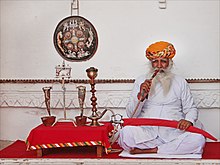**Names and Etymology:**
– The English word hookah originates from the Hindustani word huqqa.
– In Lebanon, Syria, and other countries, it is commonly known as Arjīlah or nargilah.
– In Serbia, Bosnia, and other countries, it is referred to as na[r]gile or na[r]gila.
– Albania uses the term lula or lulava for hookah.
– In Egypt, Sudan, and Yemen, it is called shīshah or madā`ah.
**History:**
– The hookah was introduced in India by Persian physician Abul-Fath Gilani during Mughal India.
– The use of the water pipe dates back to at least the time of Shah Tahmasp I in Persia.
– Tobacco was introduced to Akbar the Great by Roman Catholic missionaries in Fatehpur Sikri.
– Cannabis was commonly smoked in India before tobacco arrived in the 17th century.
– Gilani raised health concerns and developed a system to purify smoke by passing it through water.
**Spread and Popularity:**
– Hookah smoking is a global public health concern, with high usage rates in the Middle East, North Africa, and among young people in various regions.
– The hookah spread from the Indian subcontinent to Persia and then to the Near East.
– The use of hookah has become popular worldwide, especially among younger generations.
– In some regions, hookah is still used traditionally with unflavored tobacco leaves.
– Vaporizing flavored tobacco is replacing burned tobacco in modern hookahs.
**Cultural Significance:**
– Despite being taboo initially, hookah smoking became popular among nobility and widely accepted.
– The hookah has cultural significance in various regions, with different names and traditions associated with it.
– The earliest European compendium on tobacco included the Persian term qalyān.
– Different countries have their own names for hookah, reflecting its cultural diversity.
– The hookah continues to be used in traditional and modern settings, adapting to changing trends.
**Health Risks:**
– Smoking tobacco, cannabis, or other drugs through a hookah exposes users to toxic chemicals and carcinogens.
– Hookah smoking poses risks of transmitting infectious diseases and pathogenic bacteria when shared.
– Traditional hookah smoking with unflavored tobacco may result in higher nicotine content and adverse health effects.
– Water filtration in hookahs does not filter out all harmful substances present in the smoke.
– The popularity of hookah among young people adds to the global concern of its health risks.
A hookah (Hindustani: حُقّہ (Nastaleeq), हुक़्क़ा (Devanagari), IPA: [ˈɦʊqːa]; also see other names), shisha, or waterpipe is a single- or multi-stemmed instrument for heating or vaporizing and then smoking either tobacco, flavored tobacco (often muʽassel), or sometimes cannabis, hashish and opium. The smoke is passed through a water basin—often glass-based—before inhalation.

The major health risks of smoking tobacco, cannabis, opium and other drugs through a hookah include exposure to toxic chemicals, carcinogens and heavy metals that are not filtered out by the water, alongside those related to the transmission of infectious diseases and pathogenic bacteria when hookahs are shared. Hookah and waterpipe use is a global public health concern, with high rates of use in the populations of the Middle East and North Africa as well as in young people in the United States, Europe, Central Asia, and South Asia.
The hookah or waterpipe was invented by Abul-Fath Gilani, a Persian physician of Akbar, in the Indian city of Fatehpur Sikri during Mughal India; the hookah spread from the Indian subcontinent to Persia first where the mechanism was modified to its current shape and then to the Near East. Alternatively, it could have originated in the Safavid dynasty of Persia, from where it eventually spread to the Indian subcontinent.
Despite tobacco and drug use being considered a taboo when the hookah was first conceived, its use became increasingly popular among nobility and subsequently widely accepted. Burned tobacco is increasingly being replaced by vaporizing flavored tobacco. Still the original hookah is often used in rural South Asia, which continues to use tumbak (a pure and coarse form of unflavored tobacco leaves) and smoked by burning it directly with charcoal. While this method delivers a much higher content of tobacco and nicotine, it also incurs more adverse health effects compared to vaporizing hookahs.[citation needed]
The word hookah is a derivative of "huqqa", a Hindustani word, of Arabic origin (derived from حُقَّة ḥuqqa, "casket, bottle, water pipe"). Outside its native region, hookah smoking has gained popularity throughout the world, especially among younger people.
